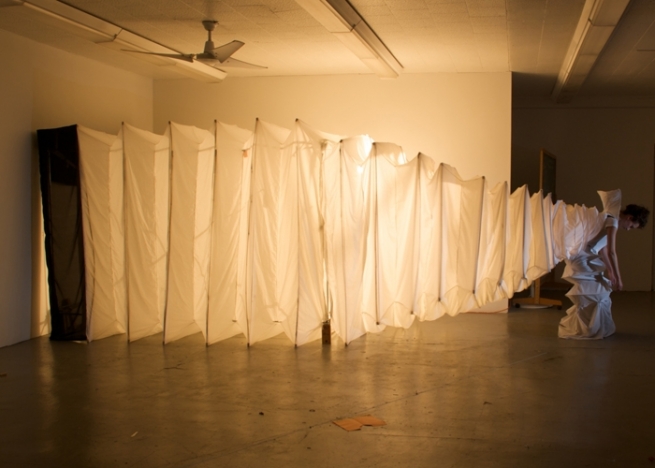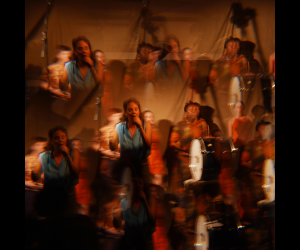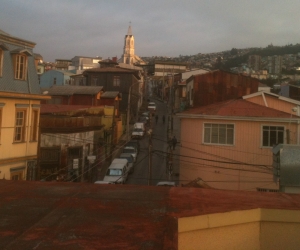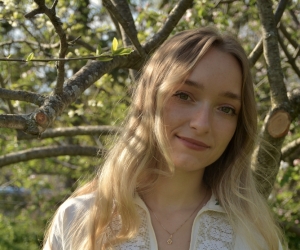
An eighty-four-foot, mixed-media triptych spans a wall at the Museum of Modern Art in New York. With three huge scrolls, each three feet high, arranged on the wall in three rows, it’s an elaborate montage on a stark, white backdrop. Photographs, texts, drawings, and lithographs make up the whole. The piece, (Untitled) 2008–2011 (the map of the land of feeling) I–III by Rirkrit Tiravanija, is a print collection of personal travel artifacts, notebook pages, bits of maps, lithographic prints, and drawings. Lengthwise across the centre of each scroll is a solid band of uninterrupted passport pages with stamps of relocation and headshots of the gradually aging artist, portraying his personal timeline.
When composer Zosha Di Castri, who is currently living and studying in New York City, came across the scrolls, the work resonated with her. Within the overall cohesion of the piece there’s another level of personal detail that gets you to look closer. Tiravanija’s layers of detail refer specifically to place: symbols of human experience and representational vignettes—an overlapping patchwork that sparked Di Castri’s imagination. “I think a good piece of music,” she says, “should also do this—draw the listener at once out and in.” In music, it is the details that you hear on repeated listening. Upon seeing the Tiravanija triptych, she imagined a dazzling array of sonic textures and distinguishable, orchestrated sound objects.
But what are the stamps on Di Castri’s musical passport? Edmonton, Montreal, Paris, and New York. “At this stage, I’m trying to experience as much as possible in as many places as possible before settling down,” she says. Di Castri has ten years of composing behind her, including small and large chamber works with instrumental, mixed, and electronic components.
Although she speaks of her personal style as being in development, she’s already achieved a great deal. She recently won two SOCAN Foundation Awards for Young Composers for her pieces Sulla mappa concava del buio and La forma dello spazio, the latter garnering The John Weinzweig Grand Prize—making her the first woman to receive this award. She also was handpicked by Pulitzer Prize-winning American composer John Adams for a commission, after she met him during her residency at The Banff Centre. “I’m very indebted to his support. It’s pretty amazing,” she says. It resulted in Di Castri’s first orchestral work, Alba, that was premiered in August 2011. And opportunities continue to blossom in the wake of her ongoing success. Di Castri’s current projects are being written under the auspices of New Voices, a commissioning and publishing initiative. Through this brand new program, Di Castri will be the first composer guided through the process of writing and publishing two new works, in partnership with music publisher Boosey & Hawkes, the New World Symphony (Miami), and the San Francisco Symphony. “For a young composer, having the opportunity to work with two such forward-looking orchestras and a renowned publishing company on both a new orchestral work and a piece for chamber ensemble is practically unheard of,” notes Di Castri. It seems like a busy schedule for someone who is also pursuing her DMA in composition at Columbia University.
Before she began her degree in New York, Di Castri did an elective year abroad through McGill University, her alma mater. Having flown to Paris to travel and to see if she could do other things besides music, she realized, “it’s fundamental to me to express myself through composition.” On discovering this, she decided to pursue private composition lessons. Paris offers many world-class composers with whom to study, and Di Castri chose composer Philippe Hurel, a major spectralist. Di Castri had become curious about spectral music after being exposed to several pieces in this aesthetic during the 2005 Montreal/New Music International Festival. “I was curious about working from sound itself,” she says. Spectralism, which originated in France in the 1970s, emphasizes timbre, and views music primarily as sound evolving through time. Studying with prize-winning composer Hurel gave Di Castri an in-depth view of France’s fresh take on spectralism and systematic contemporary composition. The spectral thread then led back to New York, where she next studied with Tristan Murail, whom she calls “one of the fathers of spectral music.”
After many years of study she now has the opportunity to develop on her own, while the faculty in the Department of Music at Columbia goes through a transition. While she values her professors and mentors, she adds, “At some point you need to take the time to figure out what it is that you want, and what your voice is.” She says it’s a time to be honest about what matters to her, and block out others’ voices just long enough to define her own.
When she talks about her ideas for her New Voices commissions, especially the piece for percussion quartet, Di Castri again speaks of visual influences. She mentions the ’60s model Peggy Moffitt as an inspiration, citing the first-ever fashion films at that time as a new kind of collaboration between photographers, designers, and models. “She moves rather than poses,” Di Castri describes with a light in her eye. Moffitt’s mod style could show up in Di Castri’s piece in the retro allusions suggested by the vibraphone and swing cymbal.
Di Castri witnesses this integration of visuals and music as a contemporary phenomenon in creative culture. “We live in a very visually stimulating culture, so it seems logical to me that this would also affect the way that composers conceive of sound.” As systematic conventions such as tonal or twelve-tone composition fade into explorations of gesture and texture, visual language becomes more relevant and descriptive as well.
While using visuals as a starting point in composition, Di Castri doesn’t approach the process literally. “I try to avoid translating an image pixel for pixel,” she says. What programmatic music has done in the past was to try to literally paint a picture or express a specific narrative in music. Limited mostly to the European Classical and Romantic traditions, program music referred intentionally to specific, extra-musical ideas, images, or events (especially poetry and artworks), in contrast to non-referential, absolute music that was purported to possess meaning in itself. Since then, the idea of absolute music has been challenged by scholars like Susan McClary, who contend that music cannot be abstracted from its political and social context. The visual–musical relationship remains a lot less explicit than in the days of program music. “A visual idea is an impulse that jolts the musical imagination awake,” explains Di Castri. But she wants to take this idea further.
Di Castri wants to see more action in today’s classical performances. She wants it to be interesting to watch. We’re all witnessing audiences of classical and serious music dwindle, and some practitioners are more willing than others to admit that it’s due to dull, predictable, and narrow performance practices. “I try to question how we might do things differently to re-engage audiences and to re-enchant [them with] the concert experience,” Di Castri says. Her answer is the hybridization of art forms. Call it mixed means, interdisciplinary art, music theatre—but whatever it’s called, it’s likely the future of contemporary music, according to Di Castri. These artistic hybrids inject life into artworks, establish lasting creative relationships, and have an impact on audiences. Di Castri isn’t alone in pursuing this tack. She cites the Montreal interarts scene as an example of this. “There is an open-minded public interested in engaging with art in new ways.” It’s a city thriving with talented and adventurous artists in diverse fields, like the Bozzini Quartet, Ensemble contemporaine de Montréal, individuals like Jean-François Laporte and David Adamcyk, and institutions like the Matra Lab, CIRMMT, and the Université de Montréal.
The scope of interdisciplinary arts collaboration reaches far and wide. The Contemporary Music Centre in Dublin, Ireland acknowledged a growing momentum in collaborations between artists and composers in a seminar entitled Visual Arts and New Music in 2006. The artists present illustrated how their creative work became more diverse and moved along more quickly when they collaborated. A conference session called Bridging visual arts and contemporary music reiterated that point last year, asking questions about what the different disciplines can learn from each other, and exploring the creative potential in the differences between the experience of listening and the experience of looking. This session was part of the current Arts and Audiences conference series, which will meet again in October 2012.
Di Castri has done her part to move the concert experience ahead in her own work. ETBTTA (Everything too big to take apart), her pieces for electronics (tape plus interactive wii) and dance was written collaboratively with Belgian choreographer Thomas Hauert and ZOO Contemporary Dance Company. During the collaborative creative process, she spent rehearsal sessions participating in dance exercises with the troupe, witnessing how the group acts as a swarm, transfers leadership between themselves, and uses partner activities to find new positions and movements that they wouldn’t have come to on their own. No doubt this gave her an experiential view on how and what to compose for dance, and she engages the notion of movement on stage in creative ways.
An interest in and study of sculpture led Di Castri to write Akkord I, a work for piano, electronics, and large kinetic sculpture. Picture a flutist and a pianist connected by a huge, glowing, accordion-like sculpture—their interactions reflected in the push and pull of a giant bellows. The piece is an interesting interpretation of the collaboration that needs to happen within any performance and that was manifested by the collaborative interarts team Di Castri assembled for the piece: Kathleen Mulder (costume and set designer), Jess Smith (theatre director), David Adamcyk (composer), and Carly Rouault (architect).
Di Castri believes that the multi-arts aspects of Akkord I affected the way in which the audience remembered the musical themes, sections, and gestures of the piece. They were more engaged in the musical specifics of her piece when they had the multisensory experience of viewing it as well. The audience’s experience with Akkord I has reinforced Di Castri’s resolve to create interdisciplinary works with the goal of enriching the new-music concert experience.
Aside from the added visual stimulus of her interarts work, Di Castri’s music can be described in visual-arts language: she works with texture and colour. It’s this textural intention that she links to her studies with noted spectralists Hurel and Murail. “Often I think in terms of orchestration. I’ve adopted that approach a bit, using this idea of a very fused sound world.” But in her experience, her approach to her craft is more eclectic than a traditional spectral approach might allow. There’s a sense when listening to her music that even the most isolated voices are working with the others towards an overall gesture. Di Castri builds huge waves of sound out of the input of many individuals, weaving the orchestra into itself. “You’re thinking of the ensemble as one, rather than as each individual part,” she says.
In listening to works like Cortège and Strange Matter the sense of movement is almost visible. Di Castri is interested in creating energy, momentum, and a sense of directionality, and it works. Her pieces come alive in a very natural way because of how she plays with memory. She gives us a memorable chord or gesture, so that when she changes it, we feel a strong sense of dynamism.
The sound palette of Di Castri’s compositions is creative and comprehensible. The use of conventional performance techniques keeps her music accessible, while their use in service of the broader gestures of the ensemble makes her music innovative. She has a strong awareness of the sonic identities of the instruments, and uses them to achieve collective musical gestures with the whole ensemble. Di Castri treats the orchestra as a sound collaboration, and we the audience are certainly engaged.
In Di Castri’s studio, visuals of music are a practical matter. Something of her spectral mentorship lingers as she examines spectrograms for harmonic and textural diagnosis. The x-ray of a specific pitch exposes the prominent formants like a rainbow of timbre for fine tweaking, “You see all the partial contents,” she says. “Rather than thinking about a sound as one note, you see what the makeup is within that.” And as Di Castri plays with the details within a larger whole, she draws the listener into a scroll of sound.
Audio: La Forma Dello Spazio (2010). Composed by Zosha Di Castri. Performed by Henk Guittart, conductor; Adrian Failla, flute; Tzuying Huang, clarinet; Claudia Schaer, violin; Gabrielle Hamann-Guénette, cello; and Hiroaki Takenouchi, piano. Image: Zosha Di Castri tries on Kathleen Mulder's large kinetic sculpture used in Di Castri's piece Akkord I. Image by: David Adamcyk.


